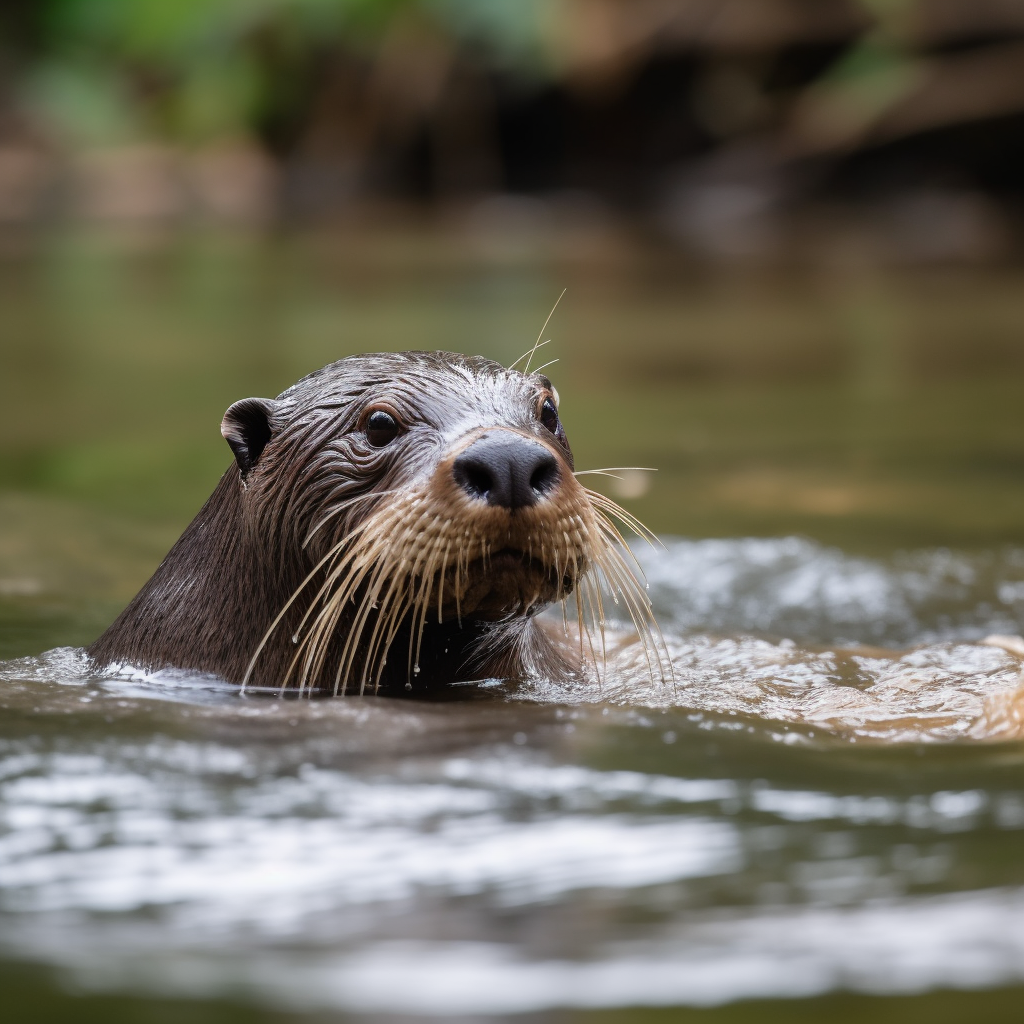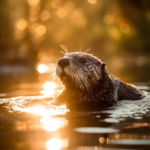The River Otter, scientifically known as Lontra canadensis, is a fascinating and charismatic mammal that can be found in various regions of North America, including the state of New York. These sleek and playful creatures are well-adapted to their aquatic lifestyle, with webbed feet, a streamlined body, and a thick, waterproof coat. River otters are highly skilled swimmers and can often be spotted gracefully gliding through the waterways of New York, such as rivers, lakes, and marshes. In this article, we will delve into the world of river otters in New York, exploring their habitat, behavior, conservation efforts, and the importance of protecting these remarkable creatures for future generations. So, let’s dive in and discover the wonders of the river otters in the Empire State!
Key Takeaways
- River otters are native to New York and can be found in various water bodies across the state.
- They are excellent swimmers and have adapted to both freshwater and saltwater environments.
- River otters play a crucial role in maintaining the health of aquatic ecosystems by controlling populations of prey species.
- Conservation efforts have helped in the recovery of river otter populations in New York, but continued protection is necessary to ensure their long-term survival.
- Observing river otters in their natural habitat can be a rewarding and educational experience for nature enthusiasts.
The River Otter in New York: An Overview

A. The New York River Otter Project: A Brief History
The River Otter, a fascinating aquatic mammal, has made a remarkable comeback in New York State over the past few decades. This resurgence can be attributed to the efforts of the New York River Otter Project, which was initiated in the 1990s to restore the otter population in the state.
The project aimed to reintroduce otters into areas where they had been extirpated due to habitat loss and unregulated trapping. Through a combination of habitat restoration, conservation measures, and reintroduction programs, the project has been successful in bringing back these playful creatures to their natural habitats.
B. Current Status of River Otters in New York State
Thanks to the dedicated conservation efforts, the population of River Otters in New York State has rebounded significantly. Once considered rare, these charismatic creatures can now be found in various regions across the state, including the Hudson River and upstate New York.
The New York State Department of Environmental Conservation (DEC) closely monitors the otter population to ensure their continued well-being. The DEC conducts regular surveys and studies to assess the otter population size, distribution, and habitat quality. These efforts help in implementing effective conservation strategies and protecting the otters’ natural habitats.
C. Presence of Otters in the Hudson River and Upstate New York
The Hudson River, a vital waterway in New York, has become a thriving habitat for River Otters. These intelligent and adaptable creatures have successfully established their presence along the river, taking advantage of its diverse ecosystem. The abundance of fish, crayfish, and other aquatic prey species in the Hudson River provides an ample food source for otters.
Upstate New York also offers suitable habitats for River Otters. The region’s numerous lakes, rivers, and wetlands provide the perfect environment for these semi-aquatic mammals. Otters can be found in areas such as the Adirondack Park, Finger Lakes region, and the Thousand Islands, where they can freely roam and thrive.
It is important to note that River Otters are elusive animals and can be challenging to spot. However, nature enthusiasts and wildlife lovers can increase their chances of observing these delightful creatures by visiting nature parks and wildlife sanctuaries known for otter sightings. These protected areas not only offer opportunities for otter spotting but also contribute to the conservation and preservation of New York’s diverse wildlife.
In conclusion, the River Otter population in New York State has made a remarkable recovery, thanks to the dedicated efforts of the New York River Otter Project and ongoing conservation initiatives. The presence of otters in the Hudson River and upstate New York is a testament to the resilience and adaptability of these fascinating creatures. By protecting their habitats and promoting responsible environmental practices, we can ensure the continued success of otter conservation in New York.
Understanding the River Otter: A North American Perspective

A. Where Does the Otter Tail River Start?
The Otter Tail River, as the name suggests, is closely associated with the river otter. However, it is important to note that the Otter Tail River is not the primary habitat for river otters. The Otter Tail River is actually located in Minnesota, and it stretches for approximately 192 miles, flowing through several counties before eventually joining the Red River of the North.
The river itself is known for its scenic beauty and recreational opportunities, attracting visitors from far and wide. It provides a diverse range of habitats for various wildlife species, including fish, birds, and mammals. While river otters may occasionally be spotted in the Otter Tail River, they are not as commonly found here compared to other water bodies in North America.
B. Habitats: Where are North American River Otters Found?
North American river otters are highly adaptable creatures and can be found in a variety of aquatic habitats across the continent. They are known to inhabit rivers, lakes, ponds, marshes, and even coastal areas. These charismatic creatures are excellent swimmers and are well-suited to life in the water.
In terms of their distribution, river otters can be found in many regions of North America, including the United States and Canada. They are particularly abundant in areas with abundant water sources and suitable prey populations. River otters are known to thrive in both freshwater and marine environments, making them versatile and resilient in their habitat requirements.
C. Are There River Otters in New Jersey?
While New Jersey may not be the first place that comes to mind when thinking about river otters, these fascinating creatures do indeed call the state home. River otters can be found in various water bodies throughout New Jersey, including rivers, lakes, and coastal areas.
In recent years, there have been increasing sightings of river otters in the state, indicating a potential recovery of their population. This is an encouraging sign, as river otters were once scarce in New Jersey due to habitat loss and pollution. Efforts to improve water quality and protect natural habitats have played a crucial role in the resurgence of river otters in the region.
If you’re interested in spotting river otters in New Jersey, some of the best locations to visit include the Delaware Water Gap National Recreation Area, the Great Swamp National Wildlife Refuge, and the Edwin B. Forsythe National Wildlife Refuge. These protected areas provide suitable habitats for river otters and offer opportunities for nature enthusiasts to observe these captivating creatures in their natural environment.
In conclusion, while the Otter Tail River in Minnesota may not be the primary habitat for river otters, these adaptable mammals can be found in various aquatic habitats across North America. This includes New Jersey, where efforts to protect their habitats have led to an increase in river otter populations. So, keep your eyes peeled and your binoculars ready, as you never know when you might catch a glimpse of these playful and elusive creatures in the wild.
The Significance of River Otters in the Ecosystem

River otters play a vital role in maintaining the delicate balance of New York’s aquatic ecosystems. These charismatic creatures have a significant impact on the environment, contributing to the overall health and biodiversity of the region. Let’s explore why river otters are important and the role they play in New York’s aquatic ecosystems.
A. Why are River Otters Important?
River otters are considered a keystone species, meaning they have a disproportionate effect on their environment compared to their abundance. Their presence or absence can have a cascading effect on the entire ecosystem. Here are a few reasons why river otters are important:
-
Predator control: River otters help regulate populations of prey species, such as fish, amphibians, and crustaceans. By keeping these populations in check, they prevent overgrazing and maintain the balance of the ecosystem.
-
Indicator of ecosystem health: River otters are highly sensitive to changes in water quality and habitat degradation. Their presence or absence can serve as an indicator of the overall health of the ecosystem. Healthy otter populations signify a thriving and well-functioning environment.
-
Nutrient cycling: River otters consume a variety of prey species, and their scat acts as a natural fertilizer. This helps in nutrient cycling, enhancing the productivity of the ecosystem. The nutrients released through their scat benefit plants and other organisms downstream.
-
Seed dispersal: River otters often travel long distances, and as they move, they inadvertently disperse seeds from the plants they consume. This aids in the dispersal and colonization of plant species, contributing to the overall biodiversity of the area.
B. The Role of River Otters in New York’s Aquatic Ecosystems
In New York, river otters play a crucial role in maintaining the health and balance of aquatic ecosystems. Here’s a closer look at their specific contributions:
-
Regulating fish populations: River otters primarily feed on fish, helping to control their numbers. By preying on smaller fish, they prevent overpopulation and ensure a healthy fish population overall. This, in turn, benefits other species that depend on fish as a food source.
-
Controlling invasive species: River otters also play a role in controlling invasive species. In New York, they have been observed preying on non-native fish species, such as carp and goldfish. By keeping these invasive species in check, river otters help protect the native biodiversity of the region.
-
Maintaining river ecosystems: River otters are excellent swimmers and spend a significant amount of time in the water. Their movements and activities help create pathways and channels in rivers, which can improve water flow and oxygenation. This benefits other aquatic organisms, such as fish and invertebrates, that rely on well-oxygenated water.
-
Educational and recreational value: River otters are a delight to observe in their natural habitat. Their playful behavior and graceful swimming make them a popular attraction for nature enthusiasts and tourists. Their presence in New York’s rivers and wetlands enhances the recreational value of these areas and promotes environmental education.
In conclusion, river otters are not only fascinating creatures but also crucial contributors to New York’s aquatic ecosystems. Their role in predator control, indicator of ecosystem health, nutrient cycling, and seed dispersal highlights their significance in maintaining the delicate balance of the environment. By understanding and appreciating the importance of river otters, we can work towards their conservation and the preservation of New York’s natural heritage.
Debunking Myths: Are River Otters Dangerous?
A. Are North American River Otters Dangerous?
River otters are fascinating creatures that inhabit various waterways across North America, including New York. Despite their playful and mischievous nature, there are some misconceptions about their potential danger to humans. Let’s debunk these myths and shed light on the true nature of river otters.
First and foremost, it’s important to understand that river otters are not inherently dangerous animals. They are not known to pose a threat to humans unless provoked or cornered. River otters are generally shy and elusive, preferring to avoid human contact whenever possible. Their primary focus is on hunting and foraging for food, not on engaging with people.
River otters have a reputation for being playful and curious, often engaging in social interactions with their own kind. However, their playful behavior should not be mistaken for aggression towards humans. In fact, river otters are more likely to retreat or swim away when they encounter humans in their natural habitat.
B. Safety Measures When Encountering River Otters
While river otters are not typically dangerous, it’s still important to exercise caution and respect their space when encountering them in the wild. Here are some safety measures to keep in mind:
-
Maintain a safe distance: When observing river otters, it’s crucial to maintain a respectful distance. Avoid approaching them too closely, as this may cause them to feel threatened or stressed. Admiring them from afar ensures both your safety and theirs.
-
Do not feed or touch them: Feeding or attempting to touch river otters can disrupt their natural behavior and may lead to dependency on humans for food. It’s important to remember that they are wild animals and should be treated as such. Feeding them can also alter their diet and negatively impact their health.
-
Observe quietly and calmly: When observing river otters, it’s best to do so quietly and calmly. Loud noises or sudden movements can startle them and potentially lead to defensive behavior. By remaining calm and quiet, you can enjoy their natural behaviors without causing any distress.
-
Respect their habitat: River otters rely on healthy river ecosystems for their survival. It’s crucial to respect their habitat by not littering, polluting, or disturbing the environment. By doing so, we can contribute to the conservation efforts aimed at protecting these amazing creatures and their ecosystems.
Remember, encounters with river otters are a rare and special opportunity to witness the beauty of New York’s wildlife. By following these safety measures and respecting their natural behavior, we can coexist peacefully with these fascinating creatures and contribute to their conservation efforts.
Conclusion
In conclusion, the reintroduction of river otters in New York has been a remarkable success story. These playful and charismatic creatures have made a remarkable comeback, thanks to the efforts of conservationists and wildlife agencies. The restoration of their natural habitats, such as wetlands and rivers, has provided them with ample opportunities to thrive. The presence of river otters not only indicates a healthier ecosystem but also brings joy to nature enthusiasts and wildlife lovers. As we continue to protect and preserve their habitats, we can ensure that future generations will have the privilege of witnessing the beauty and vitality of these fascinating creatures. Let us celebrate the return of the river otters to New York and continue to support conservation efforts that safeguard their existence.
Frequently Asked Questions
Q1: Are North American river otters dangerous?
No, North American river otters are not typically dangerous to humans. They are generally shy creatures and prefer to stay away from human activity. However, like any wild animal, they may become aggressive if they feel threatened or cornered.
Q2: Where does the Otter Tail River start?
The Otter Tail River starts at Elbow Lake in Becker County, Minnesota. It flows through several lakes and towns before joining the Red River at the border of Minnesota and North Dakota.
Q3: What is the New York River Otter Project?
The New York River Otter Project is a conservation initiative aimed at studying and protecting the river otter population in New York. The project involves tracking otter populations, studying their behavior and habitats, and implementing measures to protect their ecosystems.
Q4: Why are river otters important?
River otters play a crucial role in maintaining the health of river ecosystems. They are top predators that help control the populations of certain fish and invertebrates. Their presence is often an indicator of a healthy aquatic ecosystem.
Q5: Are there otters in the Hudson River?
Yes, there have been sightings of river otters in the Hudson River. Their presence indicates the improving health of the river‘s ecosystem.
Q6: Are there river otters in New Jersey?
Yes, river otters are found in New Jersey. They are primarily located in the northern and coastal parts of the state, but sightings have been reported throughout New Jersey.
Q7: Are there otters in New York State?
Yes, otters are found throughout New York State. They are most commonly found in the Adirondack region and the central part of the state.
Q8: Where are North American river otters found?
North American river otters are found across most of North America, from the Rio Grande to Canada and from the Atlantic to the Pacific. They inhabit a wide range of aquatic habitats, including rivers, streams, lakes, ponds, and marshes.
Q9: Do river otters live in New York?
Yes, river otters do live in New York. They were reintroduced to the state in the 1990s as part of a successful wildlife restoration project and are now found in many of New York’s waterways.
Q10: Are there otters in upstate New York?
Yes, there are otters in upstate New York. They are particularly common in the Adirondack region, where there are many suitable habitats for them.




